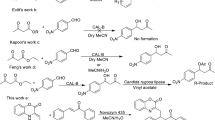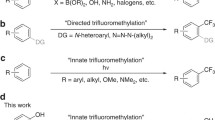Abstract
Unprotected l-phenylalanine was derivatized by an innovative enzymatic method by means of laccases from Pycnoporus cinnabarinus and Myceliophthora thermophila. During the incubation of l-phenylalanine with para-hydroquinones using laccase as biocatalyst, one or two main products were formed. Dependent on the substitution grade of the hydroquinones mono- and diaminated products were detected. Differences of the used laccases are discussed. The described reactions are of interest for the derivatization of amino acids and a synthesis of pharmacological-active amino acid structures in the field of white biotechnology.



Similar content being viewed by others
References
Berger S, Hertl P, Rieker A (1988) Physical and chemical analysis of quinones. In: Patai S, Rappoport Z (eds) The chemistry of the quinoid compounds, 2 edn. John Wiley and Sons Ltd., New York, pp 29–86
Bollag JM (1992) Enzymes catalyzing oxidative coupling reactions of pollutants. In: Sigel H, Sigel A (eds) Metal ions in biological systems, 28th edn. Marcel Dekker Inc, New York, pp 205–217
Bourbonnais R, Paice MG (1990) Oxidation of non-phenolic substrates—an expanded role for laccase in lignin biodegradation. FEBS Lett 267:99–102
Burton SG (2003) Laccases and phenol oxidases in organic synthesis—a review. Curr Org Chem 7:1317–1331
Chakraborty M, McConville DB, Niu Y, Tessier CA, Youngs WJ (1998) Reactions of primary and secondary amines with substituted hydroquinones: nuclear amination, side-chain amination, and indolequinone formation. J Org Chem 63:7563–7567
Claus H (2003) Laccases and their occurrence in prokaryotes. Arch Microbiol 179:145–150
Davin LB, Lewis NG (2005) Dirigent phenoxy radical coupling: advances and challenges. Curr Opin Biotechnol 16:398–406
Falci KJ, Franck RW, Smith GP (1977) Approaches to the mitomycins: photochemistry of aminoquinones. J Org Chem 42:3317–3319
Finley K (1988) In: Patai S, Rappoport Z (eds) The chemistry of the quinoid compounds. 2 edn. John Wiley and Sons Ltd., New York, pp 537–717
Fleck WF, Strauss DG, Meyer J, Porstendorfer G (1978) Fermentation, isolation, and biological activity of maduramycin: a new antibiotic from Actinomadura rubra. Z Allg Mikrobiol 18:389–398
Gianfreda L, Xu F, Bollag JM (1999) Laccases: a useful group of oxidoreductive enzymes. Bioremediat J 3:1–25
Jonas U (1997) Biotransformation von Biarylverbindungen durch Weißfäulepilze unter besonderer Berücksichtigung des ligninolytischen Enzymsystems von Pycnoporus cinnabarinus und Trametes versicolor. Dissertation, Mat. Nat. Fakultät. E.-M.-Arndt-Universität, Greifswald
Jonas U, Hammer E, Schauer F, Bollag JM (1998) Transformation of 2-hydroxydibenzofuran by laccases of white rot fungi Trametes versicolor and Pycnoporus cinnabarinus and characterization of oligomerization products. Biodegradation 8:321–328
Lai JH, Pham H, Hangauer DG (1996) Synthesis of a vicinal tricarbonyl amide derivative of l-phenylalanine. J Org Chem 61:1872–1874
Manda K, Hammer E, Mikolasch A, Gördes D, Thurow K, Schauer F (2006) Laccase-induced derivatization of unprotected amino acid l-tryptophan by coupling with p-hydroquinone 2, 5-dihydroxy-N-(2-hydroxyethyl)-benzamide. Amino Acids 31:409–419
Manda K, Hammer E, Mikolasch A, Niedermeyer T, Dec J, Jones AD, Benesi AJ, Schauer F, Bollag JM (2005) Laccase-induced cross-coupling of 4-aminobenzoic acid with para-dihydroxylated compounds 2, 5-dihydroxy-N-(2-hydroxyethyl)-benzamide and 2, 5-dihydroxybenzoic acid methyl ester. J Mol Catal B Enzym 35:86–92
Michalek H, Szarkowska L (1959) The quinone–amino acid complexes and polyphenolase. Acta Biochimica Polonica 6:399–409
Mikolasch A, Niedermeyer THJ, Lalk M, Witt S, Seefeldt S, Hammer E, Schauer F, Gesell M, Hessel S, Jülich WD, Lindequist U (2006) Novel penicillins synthesized by biotransformation using laccase from Trametes spec. Chem Pharm Bull 54:632–638
Mizushina Y, Ueno T, Oda M, Yamaguchi T, Saneyoshi M, Sakaguchi K (2000) The biochemical mode of inhibition of DNA polymerase β by α rubromycin. Biochem Biophys Acta 1523:172–181
Niedermeyer THJ, Mikolasch A, Lalk M (2005) Nuclear amination catalyzed by fungal laccases: reaction products of p-hydroquinones and primary aromatic amines. J Org Chem 70:2002–2008
Pachatouridis C, Iakovidou Z, Myoglou E, Mourelatos D, Pantazaki AA, Papageorgiou VP, Kotsis A, Liakopoulou-Kyriakides M (2002) Synthesis and cytogenetic effects of aminoquinone derivatives with a di- and tripeptide. Anti Cancer Drugs 13:367–372
Schauer F, Lindequist U, Hammer E, Jülich WD, Schäfer A, Jonas U (2001) Biotransformation von biologisch aktiven Verbindungen aus verschiedenen chemischen Stoffklassen mittels der Enzyme Laccase und Manganperoxidase. Patentschrift. WO 01/98518 A2
Tatsumi K, Freyer A, Minard RD, Bollag JM (1994a) Enzymatic coupling of chloroanilines with syringic acid, vanillic acid and protocatechuic acid. Soil Biol Biochem 26:735–742
Tatsumi K, Freyer A, Minard RD, Bollag JM (1994b) Enzyme-mediated coupling of 3, 4-dichloroanilin and ferulic acid: a model for pollutant binding to humic materials. Environ Sci Technol 28:210–215
Thurston CF (1994) The structure and function of fungal laccases. Microbiol 140:19–26
Ulrich H, Richter R (1977) Die para-Chinone der Benzol- und Naphthalin-Reihe. In: Houben-Weyl (eds) Methoden der organischen Chemie. 4. Aufl. (Band VII/3a), Chinone, Teil 1. Thieme-Verlag, Stuttgart, pp 402–413
Yamaoka T, Nagakura S (1971) Reactions of aliphatic amines with p-benzoquinone and its chloro derivatives. Bull Chem Soc Jpn 44:2971–2975
Acknowledgments
Financial support by means of a scholarship from the government of Mecklenburg-Vorpommern is gratefully acknowledged. We thank M. Lalk (Institute of Pharmacy, University of Greifswald), K. Weisz (Institute of Biochemistry, University of Greifswald) for providing NMR data and R. Jack (Institute of Immunology, University of Greifswald) for help in preparing the manuscript.
Author information
Authors and Affiliations
Corresponding author
Rights and permissions
About this article
Cite this article
Hahn, V., Mikolasch, A., Manda, K. et al. Laccase-catalyzed carbon–nitrogen bond formation: coupling and derivatization of unprotected l-phenylalanine with different para-hydroquinones. Amino Acids 37, 315–321 (2009). https://doi.org/10.1007/s00726-008-0154-2
Received:
Accepted:
Published:
Issue Date:
DOI: https://doi.org/10.1007/s00726-008-0154-2




